Back in September, Samsung announced two new NVMe drives. The 960 PRO is targeted to pro users and enthusiasts, and the 960 EVO aims to take the advantages of NVMe and bring it to the everyday consumer. The 960 EVO comes to market with the idea of allowing consumers to benefit from the performance, low latency, small form factor, and low power consumption of NVMe—without the professional performance price tag. While the EVO doesn’t aspire to the performance of its PRO brother, it does bring a drastic improvement over a SATA interface.

Being an M.2 form factor, the drive itself is roughly the size of a stick of gum; however, it comes in capacities of 250GB, 500GB, and even a 1TB (which we will be looking at for this review). Along with having such a high capacity for such a small device, it also comes with quoted performance of 3.2GB/s read and 1.9GB/s write, with throughput well over 350K IOPS for both read and write. This level of performance means that it would only slightly trail the 960 PRO and would give consumers a tremendous bump in performance should they upgrade their drive. While its performance can rival the Pro, the Pro does have much better endurance. While the 1TB model of the Pro can hit 800TBW, the EVO peaks at 400TBW, which ranks well compared to even enthusiast SSDs of the same capacity.
The Samsung 960 EVO comes with a 3-year warranty and a list price of $480 for the 1TB model.
Samsung 960 EVO M.2 NVMe SSD specifications:
- Form factor: M.2
- Interface: PCIe 3.0 x 4, NVMe 1.2(Partial)
- Capacities: 250GB, 500GB, 1TB
- Controller: Samsung Polaris Controller
- NAND Flash Memory: Samsung V-NAND 3bit MLC
- DRAM Cache Memory: 1GB LPDDR3
- Dimensions: Max 80.15 x Max 22.15 x Max.2.38 (mm)
- Performance (1TB)
- Sequential read: 3,200MB/s
- Sequential write: 1,900MB/s
- QD1 Thread
- Random Read: 14,000 IOPS
- Random Write: 50,000 IOPS
- QD32 Thread
- Random Read: 380,000 IOPS
- Random Write: 360,000 IOPS
- Power consumption:
- Idle (w/ APST on): 40mW
- Active:
- Read: Typ. 5.7W
- Write: Typ. 4.8W
- Temperature
- Operating: 0°C to 70°C
- Non-Operating: -45°C to 85°C
- MTBF: 1.5 million hours
- TBW: 400TBW
- Warranty: 3-year limited
Design and Build
The Samsung 960 EVO has a very similar design to the 960 PRO, which uses mostly a black color scheme (including the PCB) and measures in at just 80.15mm x 22.15mm. The parts of the M.2 drive are exposed, so users should be cautious when handling the Samsung 960 EVO, as components could be harmed.
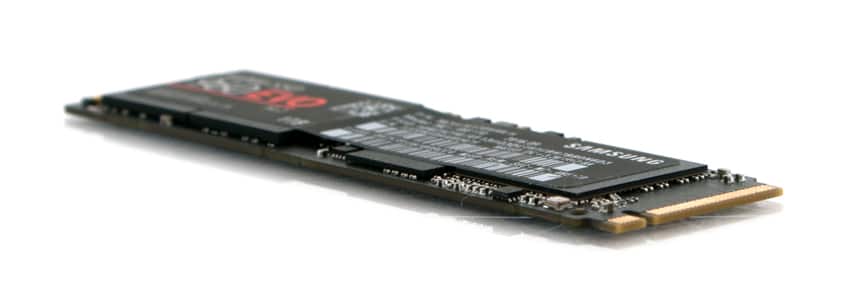
On the front side is the branding and information sticker, which covers the NAND chips and most of the PCB. It displays the Samsung branding, as well as information about the drive including the model number, form factor and capacity size. All capacities use the Samsung Polaris Controller and Samsung V-NAND.
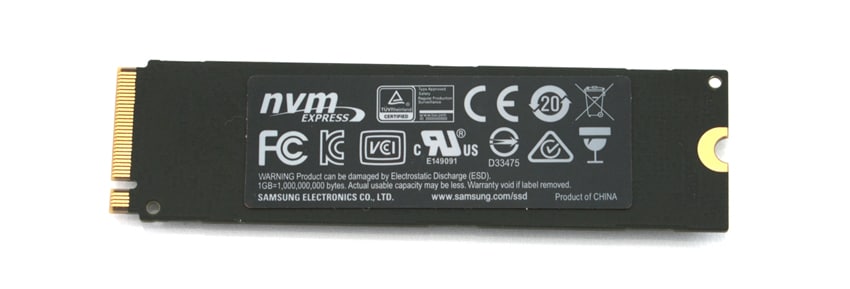
On the rear is an additional label with product certifications. This label is a bit unique though, as it is made of copper and designed to act as a heatsink underneath the controller and NAND packages.
Consumer Synthetic Benchmarks
All consumer SSD benchmarks are conducted with the StorageReview HP Z640 Workstation. We compared the Samsung 960 EVO SSD to the following drives:
- Samsung 960 Pro NVMe M.2 SSD
- Samsung SM951-NVMe M.2 SSD
- Samsung SM951 PCIe M.2 SSD
- Samsung 850 EVO M.2 SSD
- Samsung 950 Pro M.2 SSD
- OCZ RD400 m.2 NVMe 512GB
All IOMeter figures are represented as binary figures for MB/s speeds.
In our 2MB sequential benchmark, the Samsung 960 EVO recorded the best results in read with 2,308.5MB/s—even beating out the 960 Pro. On writes, it came in second with 1,660.9MB/s, only losing to the Pro version.
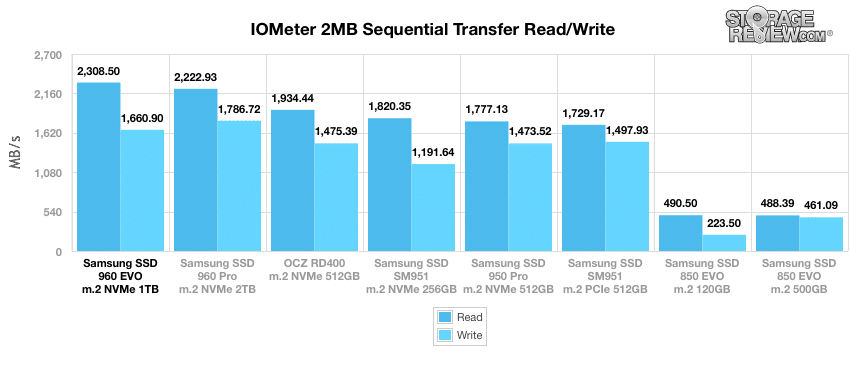
With 2MB random transfers, the 960 EVO had another upset victory with writes, coming out on top with 1,540.63MB/s. With reads, it was closer to the 850 EVOs or closer to the bottom with 1,246.34MB/s.
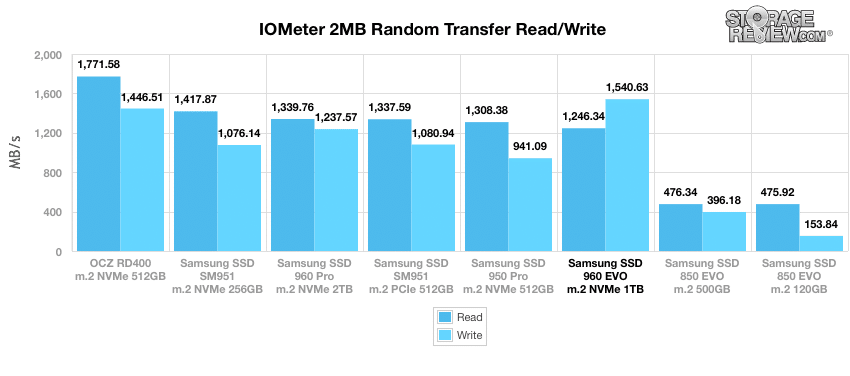
Our random 4K benchmark puts more strain on the drives in terms of throughput. The 960 EVO came in fourth in writes with 157.75MB/s and last in read with 27.7MB/s.
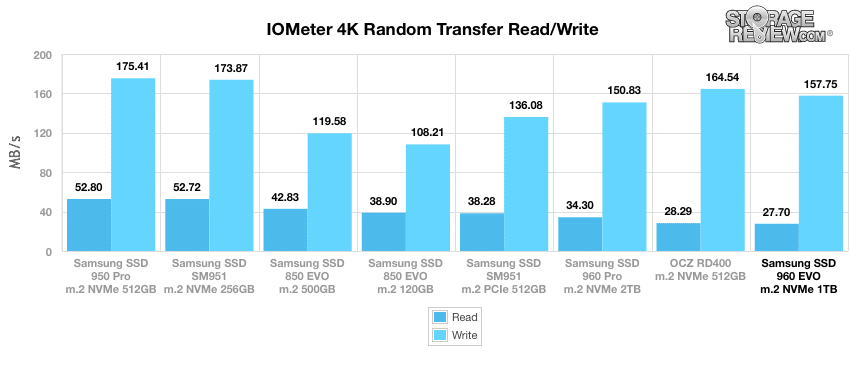
Looking the IOPS of the same test, produced the same placement with the 960 EVO again coming in fourth on the write with 40,382.95 IOPS and last in read with 7,090.59 IOPS (though in reads it was only barely behind the RD400).
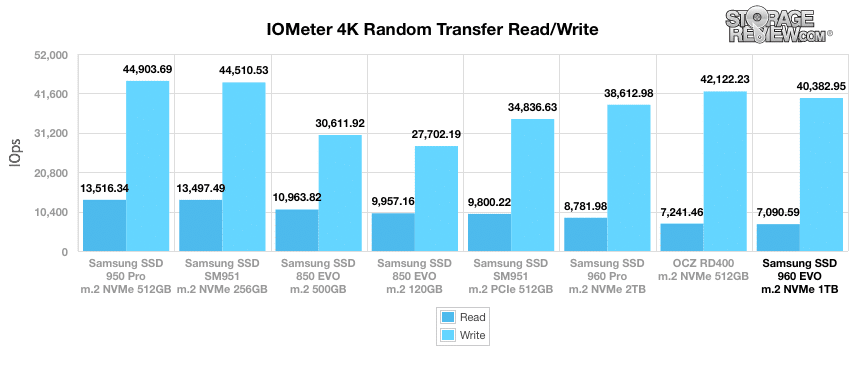
In terms of our 4K write latency benchmark, the Samsung 960 EVO had great numbers. The 960 EVO beat out the Pro version in average with 0.0244ms and came in second in max latency with 0.46ms.
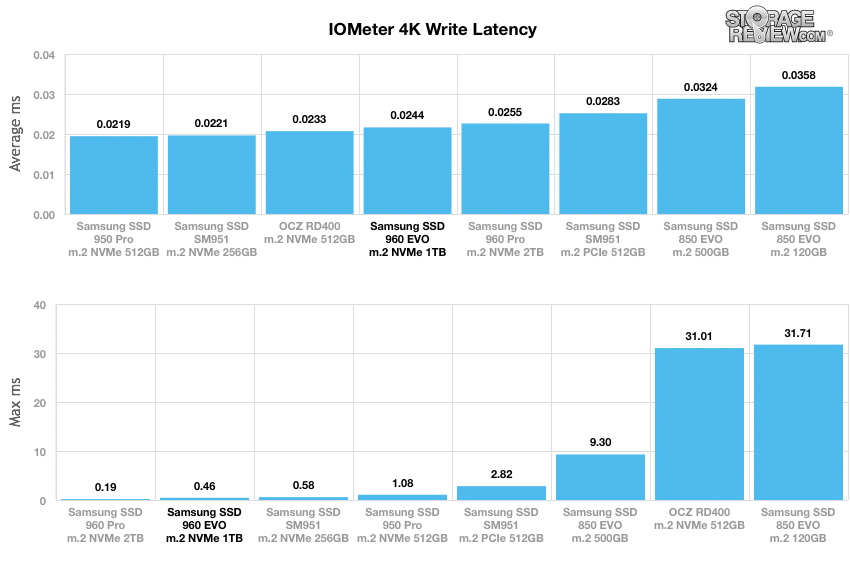
For our next 4K test, we move to a workload with 100% write activity, which scales from 1QD to 64QD. The 960 EVO did very well here, running up around 215K IOPS before settling in first with at around 201K IOPS.
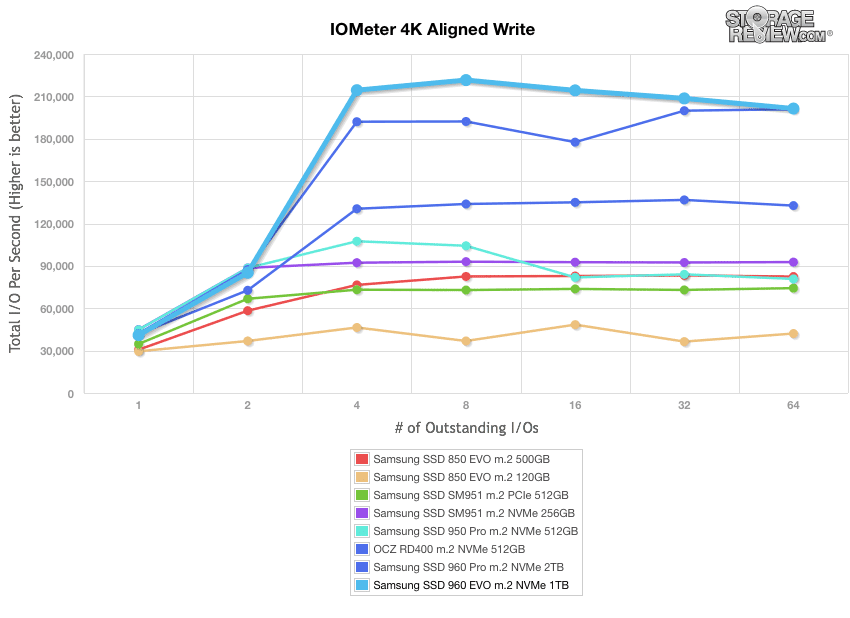
Aligned read showed the 960 EVO having a very steady climb before reaching the top spot at around 247K IOPS.
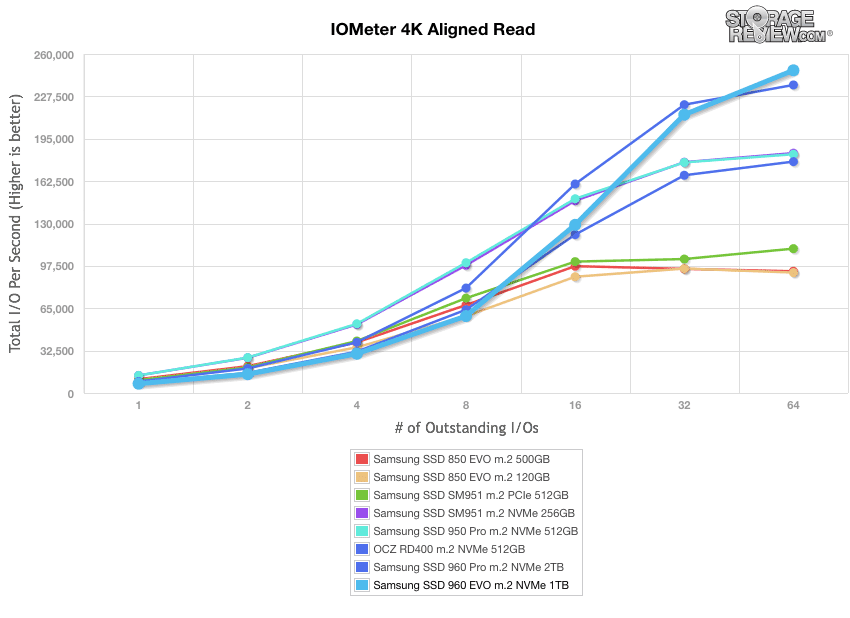
Our final consumer-synthetic benchmarks compare the drives in a series of mixed-server workloads with a queue depth of 1 to 128. Each server profile has a strong bias towards read activity, ranging from 67% read with the database profile to 100% read in the web server profile.
The database profile features a 67% read and 33% write workload, focusing on transfers around 8K in size. The 960 EVO started in the middle and stayed fairly consistent before shooting up to first place near the end—finishing above 175K IOPS.
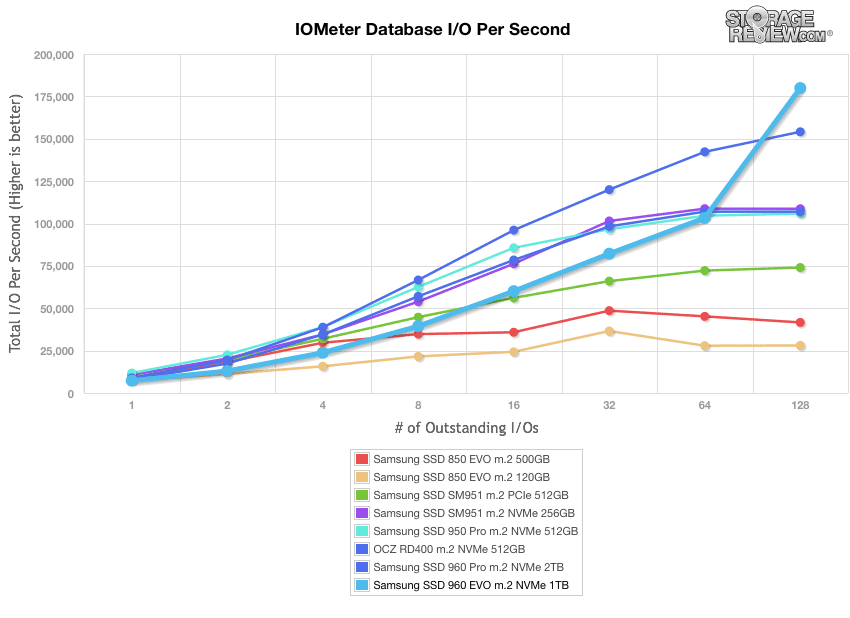
Our next benchmark is the read-only web-server profile, which uses transfer sizes ranging from 512 bytes to 512KB. In this scenario, the Samsung 960 EVO maintained a strong position during the low- to mid-range queue depths. Near the end, the Pro dropped off, letting the EVO–once again–take top spot around 96K IOPS.
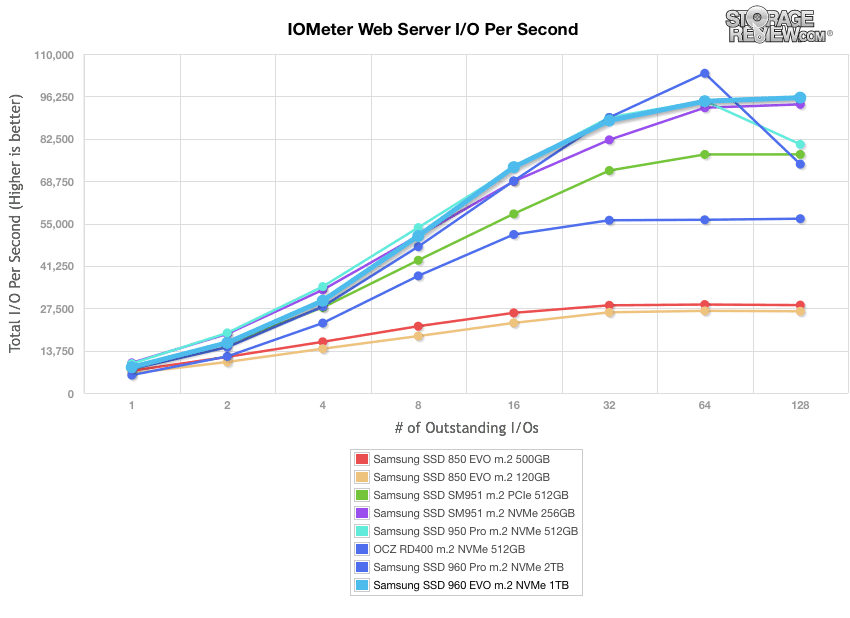
During the file-server profile, which has 80% read and 20% write workload spread out over multiple transfer sizes ranging from 512-bytes to 64KB, the Samsung 960 EVO ran in the middle to bottom here finishing right around 70K IOPS.
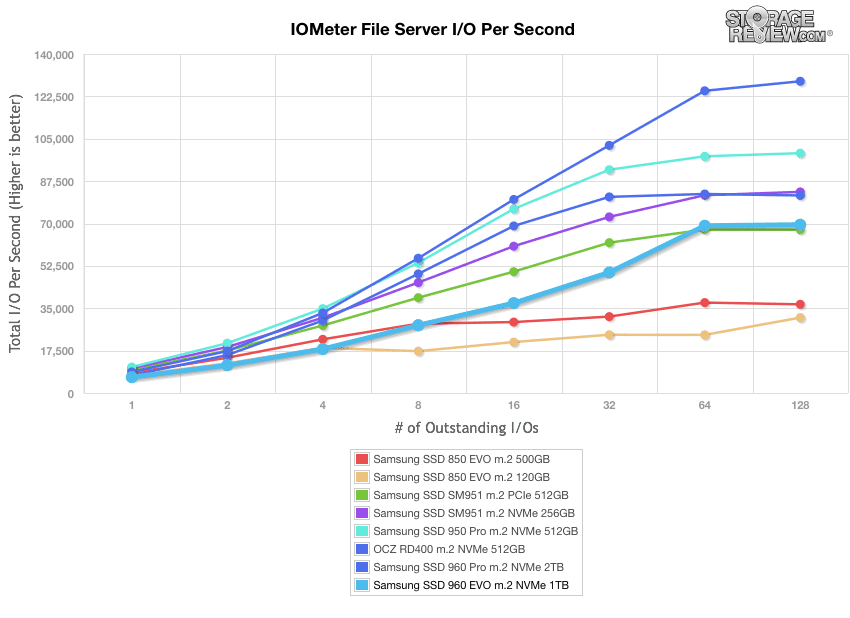
The last profile looks at workstation activity, with a 20% write and 80% read mixture using 8K transfers. The Samsung 960 EVO is not a workstation drive so there was no surprise that it didn’t hang with the top drives. It did perform well, however, finishing fourth at 110K IOPS.
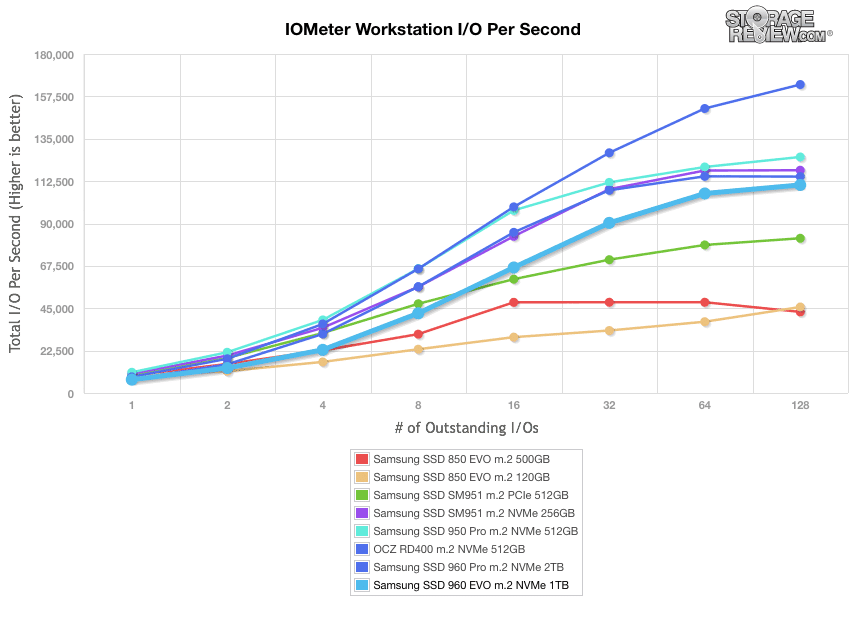
Consumer Real-World Benchmarks
While the results of synthetic benchmarks are important in identifying the key strengths and weaknesses of a drive, performance in these tests does not always translate directly into real-world situations. To get a better idea how the high-capacity Samsung 960 EVO drive will handle itself in the field, we will chart StorageMark 2010 HTPC, Productivity, and Gaming traces against comparable drives. Higher IOPS and MB/s rates with lower latency times are preferred.
The first trace is based on use as a Home Theater PC (HTPC). The test includes playing one 720P HD movie in Media Player Classic, one 480P SD movie playing in VLC, three movies downloading simultaneously through iTunes, and one 1080i HDTV stream being recorded through Windows Media Center over a 15-minute period.
While the 960 EVO did outperform the 850 EVO drives it was well behind the others in the pack. Here we saw 19,441 IOPS, 905.91MB/s, and a latency of 0.397ms.
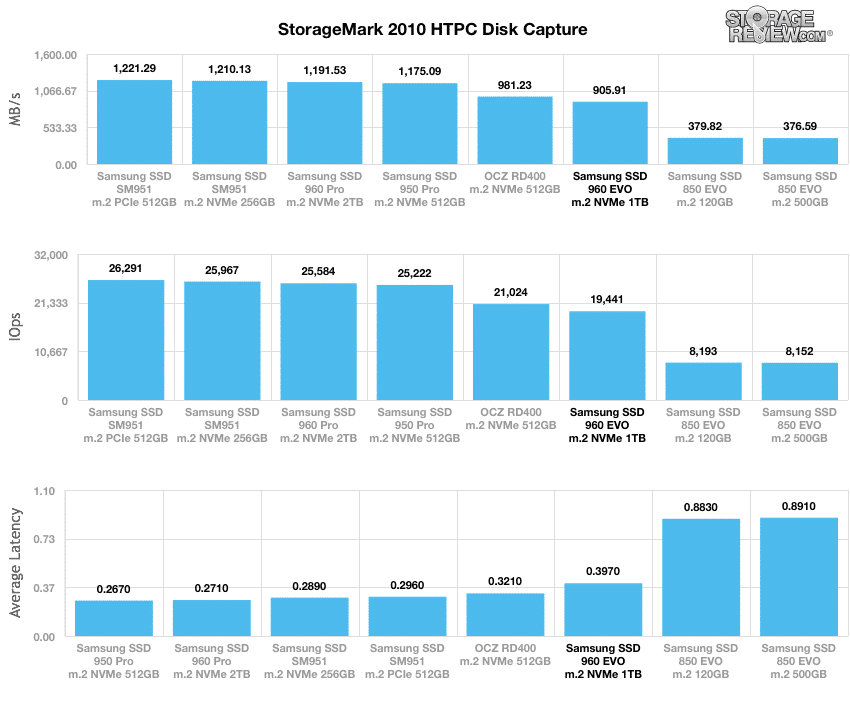
The next trace simulates disk activity in an office workstation or productivity scenario. This test includes three hours of operation in an office productivity environment with 32-bit Windows Vista running Outlook 2007 connected to an Exchange server, web browsing using Chrome and IE8, editing files within Office 2007, viewing PDFs in Adobe Reader, an hour of local music playback, and two hours of streaming music via Pandora.
In the productivity benchmark, the 960 EVO had a much better showing—coming in right behind the Pro version with 33,360 IOPS and 1,052.51MB/s. The EVO had the best latency overall with 0.228ms.
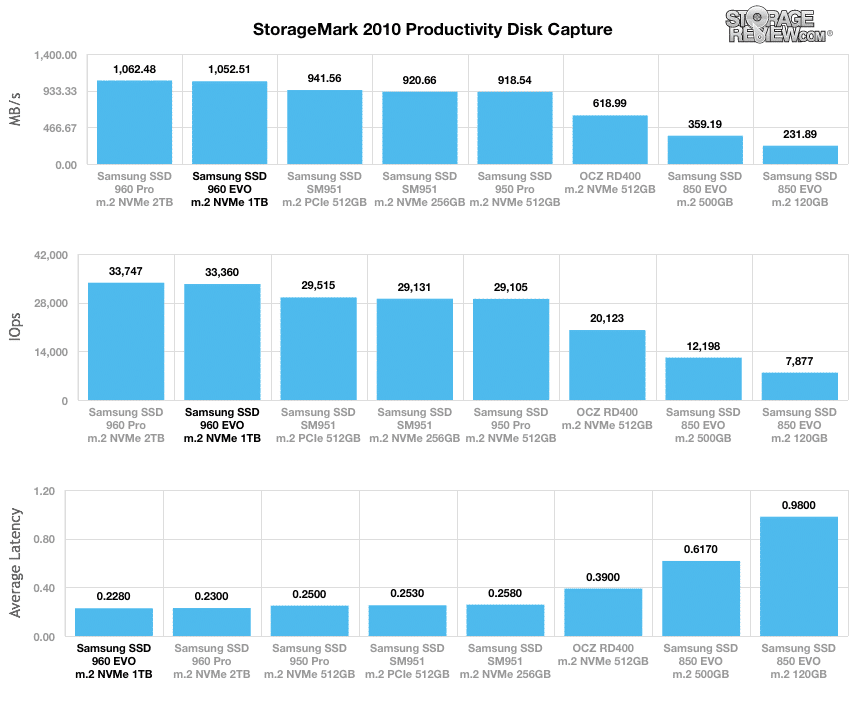
The final consumer real-life benchmark simulates disk activity during gaming. This simulation taxes the drive’s read performance, with 6% write operations and 94% read operations. The test consists of a Windows 7 Ultimate 64-bit system pre-configured with Steam, and with Grand Theft Auto 4, Left 4 Dead 2, and Mass Effect 2 already downloaded and installed. The trace captures the heavy read activity of each game loading from the start, as well as textures as the game progresses.
In our gaming benchmark, the 960 EVO once again had better performance than the 850 EVO drives, but overall was not a strong game performer with 28,991 IOPS, 1,408.63MB/s, and a latency of 0.226ms.
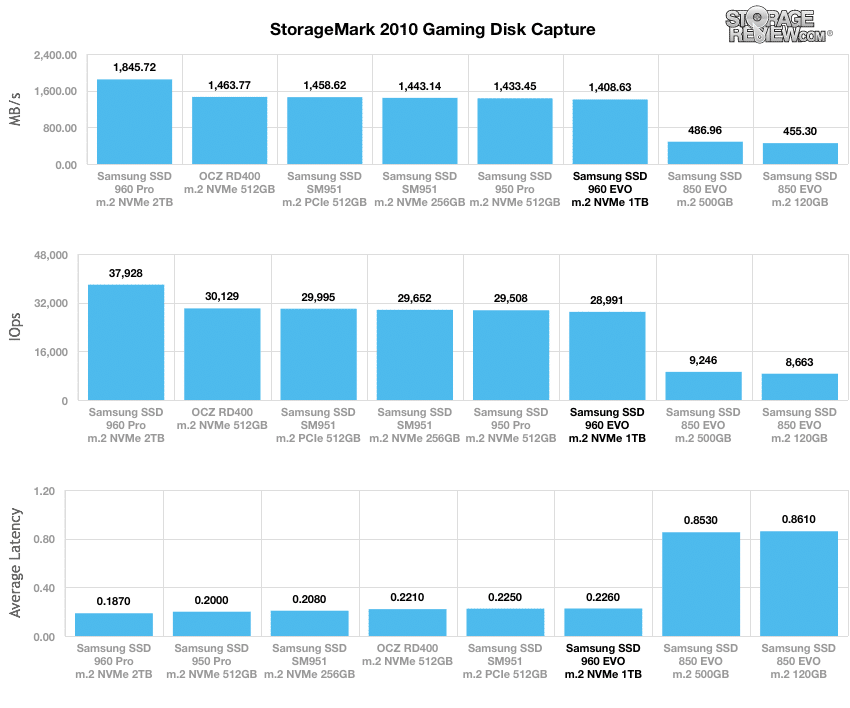
Conclusion
The Samsung 960 EVO is an NVMe SSD targeting budget-conscious shoppers in a M.2 form factor. The drive comes in three capacities: 250GB, 500GB, and 1TB. Unlike its 960 Pro brother, the EVO is aimed directly at the general consumer and priced to appeal to them. The 960 EVO has some great quoted performance (3.2GB/s read and 1.9GB/s write with throughput over 350,000 IOPS for both read and write) that is better than most drives on the market, but not as high as the Pro version.
Looking at performance, we did compare the 960 EVO to the 960 Pro (along with a handful of other drives). While this wasn’t done as a direct comparison to say the Pro is better than the EVO (as it should be), it was more to show users what they can expect from this consumer grade, cost-effective version. That being said, there were some instances where the EVO outperformed the Pro. The EVO was able to edge out the Pro in aligned read and write, as well as IOMeter Database and Web Server. In our sequential 2MB IOMeter, the EVO was able to run right up with its pumped-up performance brother, with 2.3GB/s read and 1.7GB/s write. In our real-world consumer tests, the 960 EVO showed fantastic performance, especially in our productivity trace. The Samsung 960 EVO will make shoppers set their bar higher for budget-friendly SSDs, which to date, have mainly included SATA-based offerings.
Pros
- Fastest performing value-oriented consumer M.2
- Up to 1TB of capacity
- Outperformed the Pro version in a handful of tests.
Cons
- Loses some of the top-end steam compared to the Pro model
The Bottom Line
The Samsung 960 EVO is the best performing value-oriented M.2 NVMe drive on the market, that is offered in capacities up to 1TB and starts at an affordable price.




 Amazon
Amazon